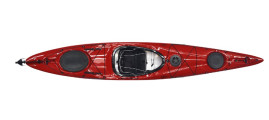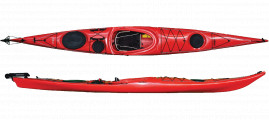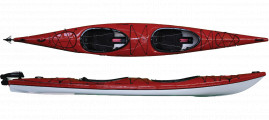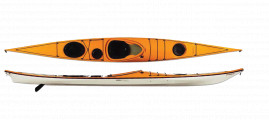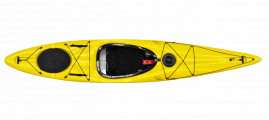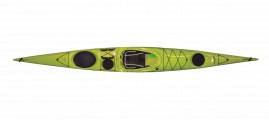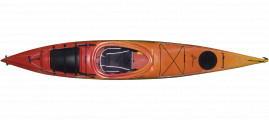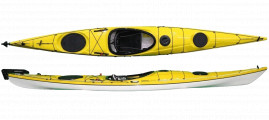Boreal Design kayaks are mainstays of the sea kayak scene, making well-respected touring kayaks for outfitters, beginners, experts and everyone in between. The Quebec-based company was founded in 1991 and grew rapidly during the sea kayaking boom of the late 1990s and early 2000s. Then, as now, Boreal Design kayaks were sold throughout North America and Europe. Today, the company is owned by Kayak Distribution Inc, which also produces Riot Kayaks, Cobra Kayaks and Beluga paddlesports accessories.
Boreal Design builds over 20 touring kayak models in different materials including budget-friendly polyethylene, lightweight thermoformed ABS and premium composite layups. Their commitment to versatile longboat design ensures there’s a sea kayak in their catalog to match the needs of almost any paddler.
Boreal Design kayaks are suited to recreational paddlers who want a more stable, responsive and comfortable kayak with better safety features than you’ll find from cheaper discount brands. Boreal Design also makes premium sea kayaks for avid paddlers undertaking multi-day trips on open coastlines.
In this article, you’ll find advice for choosing the best Boreal Design kayak for your needs and aspirations, as well as tips on buying new or used boats. Links to our Paddling Buyer’s Guide allow you to view detailed information and reviews for each model.
Top picks: Best Boreal Design kayaks for 2024
The following Boreal Design kayaks have received the highest star ratings by reviewers in our Paddling Buyer’s Guide. See and review all Boreal Design kayaks here.
Best Boreal Design Kayaks
Shop Boreal Design kayaks
Browse our comprehensive Paddling Buyer’s Guide for all the essential details on every kayak on the market. Here, you will find specifications, prices, reviews and where to buy Boreal Design kayaks. Follow the links below to filter the kayaks by type.
Shopping for a used Boreal Design kayak?
There are some important things to consider when you’re looking for a used Boreal Design sea kayak. For starters, you’ll want to check the hull (bottom) and deck (top) of the kayak for any damage. The type of potential damage will be different depending on the material from which the boat is made.
The most common damage on older rotomolded polyethylene kayaks is typically bending and warping of the plastic hull. Often this happens if the kayak was stored improperly (outside, exposed to damaging UV radiation) or overtightened on a roof rack (a good reason never to use ratchet straps). If the warp is severe enough, it can really alter the kayak’s tracking (ability to paddle straight) on the water.
This warping is known as oil canning. Fixing it involves leaving the kayak exposed to the sun for a few hours and pushing the dent out once the plastic softens. Significant damage may need a heat gun to correct. If the oil canning is severe, you may want to keep looking for a used kayak in better condition.
Thermoform ABS kayaks don’t usually suffer the same fate as polyethylene boats, and you are likely to find used thermoform kayaks that were stored correctly in much better condition. ABS kayaks are manufactured with a built-in UV protectant, but if the kayak was left in direct sunlight for prolonged periods, the plastic can become brittle and prone to cracking. Ask the owner how the kayak was stored, and check the hull for cracks.
If you are checking out an older composite kayak, look for scrapes and abrasions on the hull, particularly at the keel toward the ends and directly under the cockpit. Poke your head into the hatches or cockpit to look for areas that appear lighter. These indicate weak points in the hull where some of the material has been worn down; you may need to add a layer of gelcoat down the road. Fortunately, composite kayaks are easily repairable if you’re handy, or ask a fiberglass specialist to do the work for you.
After you’ve inspected the hull, check the components thoroughly. This includes the seat straps, foot pegs, hatches and rudder or skeg system. If you locate any damage, it’s probably repairable or replaceable. You can order replacement parts through your local Boreal Design dealer.
For more tips on what to look for when selecting a used kayak, read our article How To Buy A Used Kayak.
Boreal Design kayak buying advice
Boreal Design carries a dizzying range of touring kayaks. Beginning at 12-foot day touring kayaks appropriate for recreational and beginner paddlers, they stretch out to 17-foot models for advanced sea kayakers and 21-foot tandems. For convenience, Boreal Design categorizes their catalog by length, but there is quite a bit of variation within each of these categories. We’ll give an overview of the boats they offer, but first, let’s look at the three kayak materials available.
Boreal Design’s most budget-friendly kayaks are made with high-density polyethylene (HDPE). This is a popular choice among kayak builders because it produces durable kayaks at a relatively low price. HDPE kayaks are made using rotational molding (rotomolding), a process that involves pouring plastic pellets into a predefined mold and slowly spinning it while they heat.
The result is a one-piece boat. HDPE kayaks are strong enough to withstand most impacts. The softness of the plastic means that it flexes on impact, rather than cracking like stiffer materials. The drawback of softness is that these kayaks are a bit slower on the water; HDPE kayaks also weigh more than their thermoform and composite counterparts.
Thermoformed ABS is the next material on the price/weight gradient. Lighter than HDPE and less expensive than composite, this material incorporates aspects of both. Thermoformed kayaks are made from impact- and abrasion-resistant ABS acrylic laminates; they have the shiny and sleek look of composites and are 10- to 15-percent lighter than HDPE.
The thermoforming process involves heating and pressing sheets of ABS acrylic plastic into a mold, with one sheet for the deck and another for the hull. The two halves are then chemically sealed together. Although ABS is a plastic, it’s much stiffer than rotomolded HDPE, making the boat faster and more responsive. Boreal Design offers thermoformed ABS kayaks in two options: standard and ultralight.
Composite is often touted as the crème de la crème of kayak materials. The stiffness of the epoxy-hardened hulls makes them fast on the water, but they are still light enough that they can easily be carried. Although they can’t handle the same degree of impact as plastic boats, composites are still pretty tough. If you do find you’ve damaged the hull, you can easily repair it.
Here’s an overview of Boreal Design’s four kayak categories:
1 Day touring kayaks
12–14 feet in length
This group of kayaks is designed for those who are planning to explore local waterways on shorter outings. They share features of longer sea kayaks like bow/stern bulkheads (interior walls within the hull that ensure a kayak will float even when swamped) and decklines (cords around the perimeter of the deck that a swimmer or rescuer can hang onto)—both essential for safe paddling in more exposed waters. Some day touring kayaks also have rudders to aid with steering, although these shorter kayaks are easy to maneuver without a rudder. Their short lengths also make them easy to transport and store.
Among the shortest kayaks Boreal Design builds are the thermoform ABS Pura 120 for small- to medium-sized paddlers and Halo 130 for larger and taller kayakers. These diminutive day touring kayaks are outfitted with everything beginner or experienced paddlers need for a comfortable day on the water, including bow/stern hatches, decklines and optional rudders.
The Kasko and its wider sibling, the Oopik, are stable 13-foot recreational kayaks. They are made from polyethylene, making them affordable and durable.
The 14-foot Compass 140 looks much like a full-size touring kayak in a more compact package. This thermoform kayak has decklines around the perimeter and a tapered design for efficient glide and tracking (the tendency of a kayak to paddle in a straight line), along with a multi-chine hull for better secondary stability than a typical recreational kayak. Secondary stability describes how stable a kayak is when held on edge, an important factor for more advanced paddlers who plan to paddle in more dynamic waters. The Compass 140 cockpit provides a secure fit for enhanced boat control.
2 All around (day/weekend touring) kayaks
14’6”–16 feet in length
Kayaks in this category are short enough for fun and nimble day paddles, but have ample storage capacity for a weekend’s worth of camping gear. This size offers maneuverable handling and turning, with enough length for good glide and tracking.
Two of the three sizes of Boreal Design’s popular Storm series fall within this range. The Storm is a versatile thermoform ABS kayak that is nimble enough for rough water but still tracks reasonably well on long days. It’s available in 15-, 16- and 17-foot lengths to fit a variety of paddler sizes.
Look to the polyethylene Muktuk for wide hatches that can accommodate large dry bags; the Sedna paddles easily, with great stability for small-medium paddlers.
The lightweight composite Pakesso is the premium boat in this range, and it can be equipped with a skeg or rudder.
3 Expedition touring kayaks
16’5”–18’4” in length
These expedition-ready sea kayaks boast enough storage space for carefully packed multi-week adventures. Their speed, efficiency and gear-hauling ability make them ideal for paddlers who like to cover miles, and quickly. Choose from skeg or rudder models, and polyethylene, thermoformed ABS or composite layups.
Drawing on the sharp lines and low-to-the-water profile of traditional Greenland kayaks, the Ellesmere cuts through waves with a keyhole cockpit for a snug fit and drier ride. Originally introduced as a plastic version of the Ellesmere, the Baffin is now available in small, medium and large sizes with your choice of HDPE, thermoformed ABS or composite construction.
The Epsilon series of kayaks is also available in three sizes and is renowned for its impressive primary stability (how stable a kayak feels when held level on calm water—a great metric for beginners) and ample space. Epsilons are favorites of outfitters because they’re easy to use, can pack a ton of gear and still hold their own in moderate sea conditions. Like the Baffin series, Epsilons are available in your choice of HDPE, thermoformed ABS or composite material.
The Chinook is another stable thermoform cruiser with lots of volume. It’s a good choice for sea kayakers who enjoy wildlife viewing, fishing or photography in calmer waters.
The long waterline of the Inukshuk makes it one of the fastest polyethylene kayaks around, and it’s great for paddling long days on exposed coastlines.
Long and narrow, the 18’4” Labrador is Boreal Design’s fastest touring kayak, with exceptional glide and tracking. This composite kayak is best suited to experienced paddlers who want to take on extended trips on open waters.
4 Specialty and tandem kayaks
Boreal Design’s three different tandem kayaks cover a wide range of uses. The sturdy Esperanto polyethylene tandem is exceptionally stable, with an option for a third child seat in the middle hatch. For speed and storage, look at the composite Beluga; it’s a fantastic choice for tandem trippers or rough-water paddling. The thermoform Passage is a compromise between the Esperanto’s stability and the Beluga’s speed, still providing large cockpits for easy entry but without the spacious middle hatch.
The 16’6” Vital and 17-foot Vaag specialty kayaks are highly rockered playboats for surfing and rough water paddling. Rocker describes the amount of upsweep at the ends of the kayak; more rocker equals greater maneuverability and the tendency to ride up over waves, rather than punching through them. These sleek boats are happiest in bumpy waters and are best paddled by experienced kayakers who are comfortable in a snug, narrow kayak. They can be taken on multi-day trips with efficiently packed gear stashed in the low-volume hulls, but they really shine on shorter, playful outings.
-
Boreal Design kayak prices
Boreal Design kayak prices vary depending on the model and material selected. Shorter HDPE (high density polyethylene) kayaks are the least expensive, and longer composites cost the most, owing to the more expensive materials and additional labor needed to build these boats.
-
Where are Boreal Design kayaks made?
Boreal Design’s plastic kayaks are made overseas in Kayak Distribution’s new factory in Xiamen, China. They’ve just moved to this factory, which has a larger production capacity than their previous manufacturing facility in Shanghai.
Boreal Design kayak reviews
Paddling Magazine is your best online resource for kayak reviews. Reviews shed light on the finer details that may not be apparent when just looking at photos and product specifications. Reading reviews of kayaks gives you a better understanding of each boat’s strengths and limitations. When you find one that matches your needs perfectly, remember, it’s always best to “try before you buy.”
- Boat Review: Boreal Design Epsilon C200
- Boat Review: Boréal Design Baffin Kayak
- Sea Kayak Review: Boreal Design Labrador
- Boat Review: The Pakesso by Boreal Design



